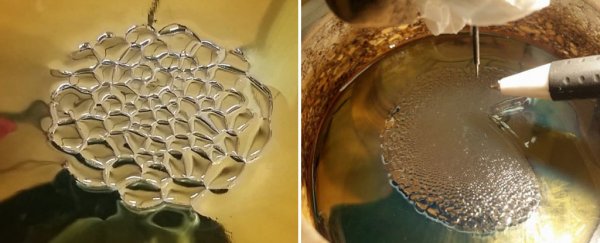The electric honeycomb, or rose window instability, is a curious phenomenon.
It occurs when a high-voltage corona charge - the ionisation of air surrounding a conductor - is applied from a vertical needle over oil on a steel plate. The surface wrinkles up into a structure resembling a honeycomb, or a rose window - hence the name.
This pattern is an instability caused by the build-up of ions applying pressure to the surface of the low-conductivity oil between the two metal conducting materials as the ions attempt to ground, pushing the oil thinner and thinner so they can get through. But the oil wants to maintain its surface structure, so the pattern forms.
And now, for the first time, someone has photographed the movement of those ions. And that someone is a 17-year-old from Pakistan.
 Muhammad Shaheer Niazi (Lahore University of Management Sciences)
Muhammad Shaheer Niazi (Lahore University of Management Sciences)
High school student Muhammad Shaheer Niazi of Lahore College of Arts and Sciences was assigned the problem of the electric honeycomb at the 2016 International Young Physicists' Tournament in Russia.
Upon returning home, he decided to try and get published - but in order to do so, he needed to contribute to the existing research and knowledge.
"We have to add something new to get published, and I introduced two new factors in the electric honeycomb phenomenon," he said on Pakistani news program NewsWise.
 RSOS
RSOS
To photograph the movement of the ions, he used a technique called Schlieren photography, an optical method used to see fluid densities. We can't, for example, usually see changes in temperature or gases in the air, but since they refract light they can cast shadows.
When the ions in the electric honeycomb experiment move from the conducting needle, they create a small wind, and it's this that shows up in Niazi's photographs, as seen in the image above.
He also used thermal imaging to photograph the temperature changes over the oil as the honeycombs form, increasing and spreading out from directly under the needle. These temperature changes, the paper notes, are due to residual gas heating and exothermic reactions.
However, they're also somewhat puzzling. No one has measured the temperature before, and according to physicist Alberto T. Pérez Izquierdo, who wrote a paper on electric honeycombs in 1997, the heating effect is larger and less even than expected. More research is required to figure out why.
Niazi's paper has been published in the peer-review journal Royal Society Open Science - perhaps foreshadowing greatness ahead.
"Newton was 17 when his first research got published in the same journal," Niazi said.
